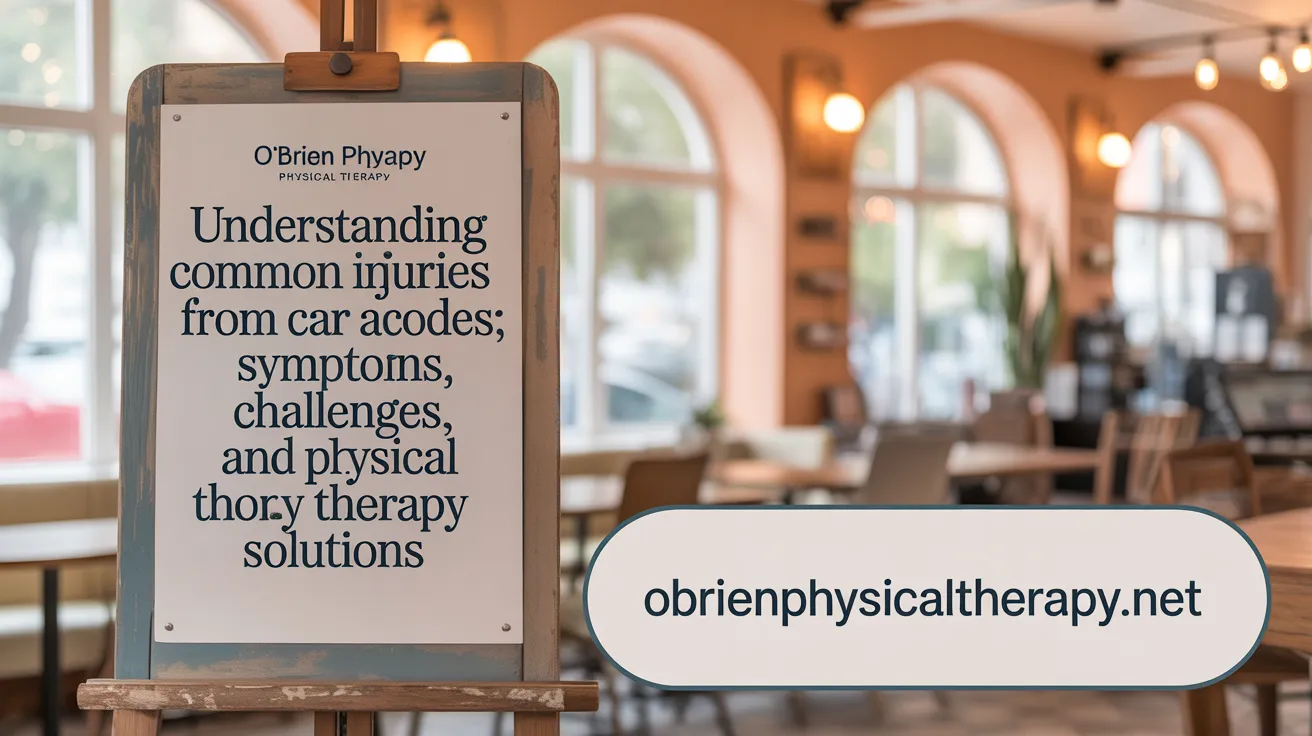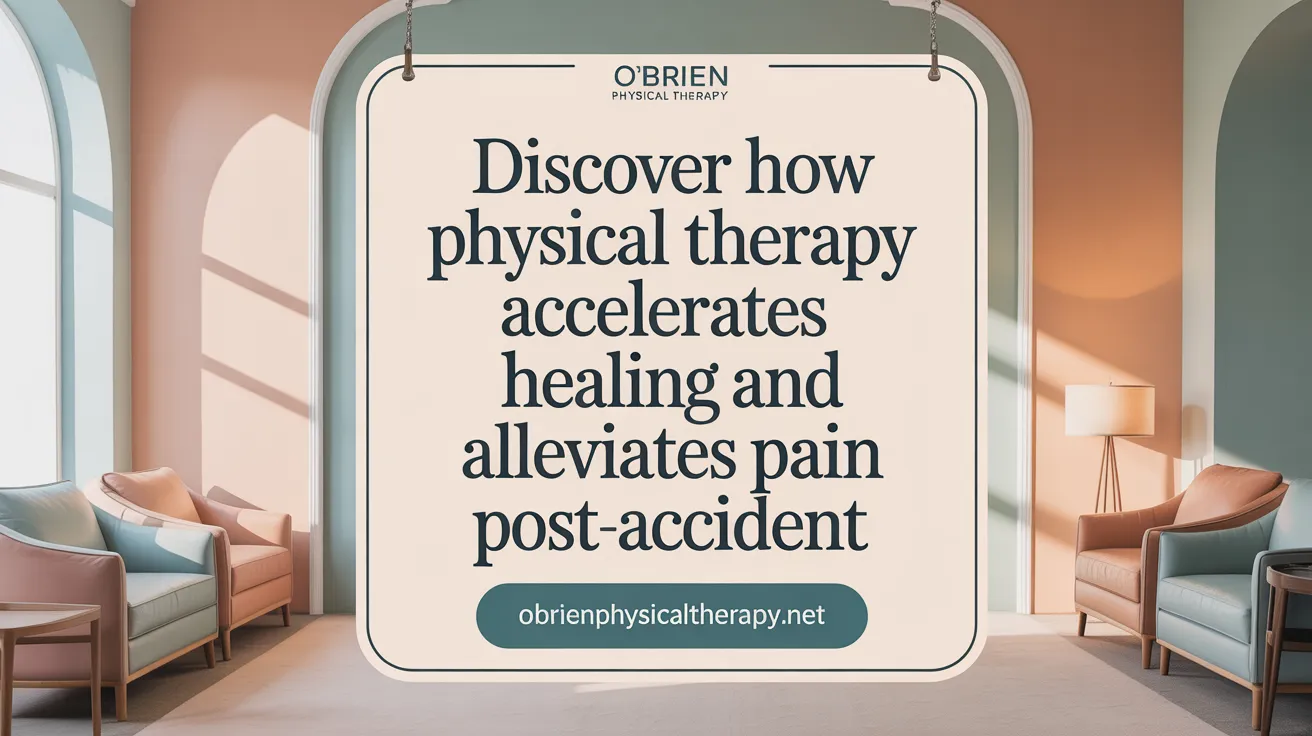Understanding the Impact of Car Accidents on Health and the Need for Rehabilitation
Car accidents can result in a wide range of injuries, from minor sprains and soft tissue damage to severe trauma such as whiplash, spinal injuries, concussions, and fractures. Though the initial danger may pass, many injuries manifest symptoms days or even weeks later, making timely medical evaluation essential. Physical therapy emerges as a cornerstone of effective recovery, aiming not only to reduce pain and restore function but also to prevent long-term disabilities and promote holistic well-being.
Common Injuries from Car Accidents and Their Challenges

Typical car accident injuries
Car accidents often cause a variety of injuries that physical therapy after car accidents can effectively address. These include whiplash, which results from sudden neck movements, back and neck injuries such as herniated discs, and soft tissue damage like sprains and strains. Head injuries ranging from concussions to traumatic brain injuries are also common. Fractures and chest injuries may occur, along with joint problems affecting the shoulders, knees, and hips.
Symptoms that may not appear immediately
Many injuries from car accidents have symptoms that do not manifest right away. Pain, stiffness, headaches, dizziness, or numbness can take hours or even days to present. This is often due to adrenaline temporarily masking discomfort and injury severity. Therefore, it is crucial to seek medical evaluation after car accident within 72 hours of the accident, even if you feel fine.
Complexities of soft tissue and spinal injuries
Soft tissue injuries and spinal injuries pose particular challenges as they may involve muscles, ligaments, tendons, or nerves. These injuries can reduce range of motion, cause persistent pain, and impair daily function. Prompt physical therapy can help restore mobility, rebuild strength, and prevent further complications through targeted exercises and manual therapy.
Risks of untreated injuries becoming chronic
If left untreated, car accident injuries risk becoming chronic, leading to long-term pain and disability. Conditions like migraines, chronic stiffness, or degenerative disc disease can develop. Early intervention through physical therapy reduces these risks by promoting healing, improving circulation to injury sites, and preventing compensatory movement patterns that cause additional strain. Learn more about how physical therapy can prevent long-term disabilities after a car accident.
How Physical Therapy Facilitates Healing and Pain Management

How does physical therapy help in reducing pain after a car accident?
Physical therapy is highly effective in alleviating pain following a car accident. Techniques like massage therapy and joint mobilization relieve muscle stiffness and joint discomfort. Modalities such as ultrasound, heat, cold therapy, and electrical stimulation increase circulation, which delivers more oxygen and nutrients to injured tissues. This flow aids in reducing inflammation and accelerates tissue repair, bringing significant pain relief.
Promotion of healing through increased blood flow
One of the fundamental benefits of physical therapy is the promotion of healing by enhancing blood flow to the injury site. Specific therapeutic exercises and manual therapies increase oxygen and nutrient delivery essential for repairing damaged muscles, ligaments, and tendons. This process speeds up recovery and supports tissue regeneration even in old injuries, improving overall mobility and function.
Manual therapies and modalities
Physical therapists use an array of treatments tailored to patient needs, including massage therapy to relax muscles, ultrasound therapy to stimulate tissue repair, and targeted stretching to restore flexibility. Ice and heat therapies control swelling and soothe pain, while aquatic therapy offers low-impact exercise options. These combined approaches provide a holistic and customized recovery plan.
Non-invasive alternatives to surgery
Physical therapy strengthens the musculoskeletal system, stabilizing injured areas and reducing strain on affected structures. Strengthening ligaments, tendons, and muscles can eliminate the need for surgical intervention by protecting joints and improving functionality. Additionally, therapy reduces dependence on pain medications, offering a safe and effective alternative for long-term recovery such as avoiding pain medication with physical therapy.
Tailored Physical Therapy Treatments and Exercises for Auto Injuries
What types of therapeutic exercises and treatments are common in car accident recovery?
Therapeutic exercises after a car accident focus on restoring mobility, reducing pain, and rebuilding strength. Common exercises include chin tucks, side-to-side neck rotations, shoulder circles, shoulder squeezes, and heel slides. These movements target areas frequently affected by auto injuries such as the neck, shoulders, hips, and knees.
Manual therapy techniques play a significant role in treatment. These involve hands-on approaches like massage therapy to relieve muscle stiffness and joint mobilization or manual manipulation to improve flexibility and reduce pain. Dry needling may also be used to target trigger points and promote muscle function.
Aquatic therapy provides a low-impact environment to perform exercises, enhancing flexibility and strength without stressing injured tissues. Stretching routines are also essential for improving range of motion and preventing stiffness in affected areas.
Physical therapists design personalized treatment plans tailored to each individual's specific injuries and recovery goals. This customization ensures the most effective combination of exercises, manual therapies, and modalities such as ultrasound and electrical stimulation to promote healing and prevent long-term complications.
By integrating these varied treatments and targeting therapy to the patient's needs, physical therapy supports a faster, more complete recovery after auto injuries.
Importance of Early Intervention and Ongoing Therapy
When should physical therapy begin following a car accident?
Physical therapy should start as soon as possible, ideally within days to a few weeks after the car accident once medical clearance is given. Early intervention accelerates recovery by managing pain and inflammation effectively. It also prevents secondary injuries and the development of chronic complications such as long-term pain and stiffness. For more details, see Benefits of early physical therapy after motor vehicle accidents and when to start physical therapy after a car accident.
Benefits of starting therapy soon after injury
Starting physical therapy early promotes better healing by improving blood flow, oxygenation, and nutrient delivery to injured tissues. This helps reduce pain and swelling while restoring mobility quickly. Early therapy also decreases the risk of degenerative conditions like chronic headaches, migraines, or disc disease, leading to a smoother, faster return to daily activities. Learn more at Pain management with physical therapy and Physical therapy after car accidents.
How long does physical therapy usually last after a car accident?
Therapy duration varies depending on the injury’s severity, the patient’s progress, and personal recovery goals. For most moderate soft tissue injuries, physical therapy typically lasts six to twelve weeks. More severe injuries or complications may require months of treatment, with adjustments tailored continuously to the patient's healing status. For further information, visit Physical therapy duration after car accidents and Duration of physical therapy.
Why is proper documentation and timing important for physical therapy related to insurance claims?
Proper and timely medical documentation of evaluations, treatments, and progress is essential for insurance reimbursement and legal claims. Many insurance policies require therapy to begin within specific time frames—often within 14 days of the accident—to qualify for coverage. Accurate records support injury compensation and help validate the need for ongoing therapy during settlement or legal proceedings. Maintaining consistent attendance and following therapy guidelines not only enhances recovery but also strengthens a patient’s position in insurance and legal matters related to the accident. Additional insight is available at Injury Documentation for Insurance and Physical therapy and legal compensation claims after accidents.
Holistic Benefits of Physical Therapy Beyond Physical Recovery

How does physical therapy contribute to overall well-being after a car accident?
Physical therapy offers more than just physical healing; it significantly enhances mental health and overall well-being after a car accident. Besides reducing pain and restoring mobility, physical therapy boosts a patient's confidence and mood by promoting a sense of progress and achievement during recovery. For more insights, see Benefits of Physical Therapy.
Therapists can address vertigo and balance problems commonly caused by vestibular system dysfunction after a crash. Vestibular rehabilitation often yields rapid improvement, sometimes resolving dizziness in a single session, which helps patients regain stability and confidence. Learn about Vestibular System Therapy for Accident Victims and Vestibular rehabilitation for concussion.
Physical therapists frequently collaborate with multidisciplinary care teams, including pain management specialists and mental health counselors, to provide comprehensive support. This team approach ensures that both the physical and emotional challenges of injury recovery are managed effectively. Read more on Multidisciplinary care after car accidents and Physical therapy and pain management collaboration.
Empowering patients is a central goal of physical therapy. Through tailored education and personalized treatment plans, patients learn to maintain gains, prevent re-injury, and manage their health long-term. This empowerment enhances independence and promotes sustained well-being well beyond the initial healing period. For additional details, see Personalized Physical Therapy Plans and Empowering patients in managing conditions.
Physical Therapy: A Vital Path to Recovery and Independence
Physical therapy stands as a vital component in recovering from car accident injuries, offering tailored, evidence-based treatments that reduce pain, restore mobility, and prevent long-term complications. Starting therapy early amplifies these benefits, supporting not only physical healing but also mental and emotional well-being. Through personalized rehabilitation plans and multidisciplinary collaboration, physical therapy empowers patients to regain independence and improve their quality of life, often preventing the need for surgery or prolonged medication. Ultimately, physical therapy is essential for a comprehensive, effective recovery journey after a car accident.
